DOWNTOWN / UNIVERSITY / 4TH AVE
December 2016 Issue
This month, “Gifts of Tucson” a gift guide to local makers, artists and authors… and our 2016 Year in Pictures. Read the digital edition of the December 2016.
The Mesquite Harvest
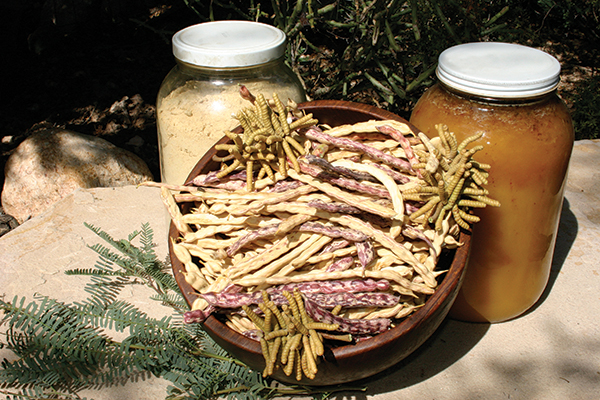
Screwbean, velvet, and honey mesquites pods. Photo by Brad Landcaster
It’s So Much More Than Just Milling Flour
It’s summer time again and, as many of you already know, that means it’s also mesquite harvesting and milling season in Tucson. And where including mesquite flour in your diet is a great way to add some diversity of flavor to your favorite culinary staples, Desert Harvesters Co-Founder Brad Lancaster would like you to know that the production and cultivation of native wild foods here in Tucson goes much, much further than simply whetting the appetites of local foodies. “We’re trying to get everyone to see the whole picture,” says Lancaster, “so the harvest is way more than just the pods.”
Our current agricultural system, says Lancaster, is based on “using imported plants, imported water, and imported fertilizer,” all of which, he points out, takes a major toll on our environment. But the plants that are native to the Tucson area—and that sustained life here for thousands of years before we were tapping the Colorado River as our primary water source—require no such interventions. The native wild food producing plants like the mesquite and ironwood trees, and the cholla and saguaro cacti, he says “are plants that can not only survive here, but thrive here with no imported water or fertilizer.” That’s why Lancaster says that Desert Harvesters is “looking at how we can use what we already have for free in a way that doesn’t deplete the ground water, doesn’t deplete the surface water…but reinfuses our ground water and reinfuses our rivers with water while reducing flooding.” And, Lancaster says, planting native wild food plants “where we live, work, and play,” while incorporating what he calls “water harvesting earthworks” helps to do all of these things while simultaneously improving our city’s landscape, as well as the habitat for local wildlife.
For this reason, though he says that local landscapes are currently dominated by non-native mesquite species that were largely selected for their tendency to grow quickly, Desert Harvesters focuses its efforts on the three types of mesquite tress native to the region—the screwbean, velvet, and honey mesquites. Not only are the local trees more consistent in taste and texture than imported varieties, but Lancaster says that they are also more beneficial to a number of native birds and insects. He says that a native mesquite will attract over sixty different native pollinators, whereas a non-native tree only attracts about a dozen. Thus, birds like the Wilson’s warbler have adjusted their migration patterns to coincide with the blooming cycles of native mesquites, and have therefore come to depend on those cycles in order to fatten up before the annual trip to their summer range about two-thousand miles north.
In support of their mission to increase the abundance of native wild food plants growing in and around Tucson, Lancaster says that Desert Harvesters is planning at least one seed-gathering expedition to look for native mesquites that taste great, ripen pre-monsoon (to avoid the growth of toxic, invisible molds that begin after the rains), and produce dense pod clusters for ease of harvesting. The group intends to harvest the seeds of these tress to sell at their events. That way, interested parties can be sure that they are planting native trees that not only provide summer shade and excellent wildlife viewing opportunities year-round, but will also provide them with a few pounds of naturally sweet, gluten-free flour every summer to utilize as they see fit. Lancaster says that some of his favorite uses for mesquite include making crackers, pie crust, and pizza dough, or using it to mix with or make coffee. He says it can also be cooked down and made into a syrupy sweetener that actually slows the body’s intake of sugar, making mesquite an ideal food for people who suffer from hypoglycemia or diabetes.
Lancaster says that mesquite beans produce a wide range of flavors, from “sweet, to nutty, to sweet-and-sour, to kind of lemony,” and that each and every tree is unique in its flavor profile. Thus, he says it’s important to sample from a number of trees when trying to find your prefect pod for harvest. He says that, when sampling from a mesquite, you should be sure to actually pick from the tree and not from the ground, and that “the pod should be dry enough that, when you bend it, it immediately snaps in two.” It should also be completely yellow, without any green left on it. You can gently work the bean with your teeth and tongue to extract the flavor when sampling, then spit it out. But be careful, as Lancaster says that the seeds are hard enough to crack a tooth. The hammer mills they use to turn the pods into flour, however, are strong enough to grind those seeds right along with the rest of the pod. When sampling mesquite beans, Lancaster says that you will not only want to taste for the presence of any one of the four “bad flavors,” which are “bitter, burning, chalky, or drying of the mouth or throat,” but that you should also look for beans that are particularly good-tasting to you. And it’s not enough to decide simply based on the initial flavor experience, says Lancaster, but that you should also wait for the aftertaste before making a final judgment. “It doesn’t matter how good of a cook you are,” he says, “you can’t take a bad flavor out of a bad-tasting pod.”
The mesquite-harvesting events this season kicked off with a fundraiser at La Cocina on May 31 which featured live music, along with food and drinks made from local wild ingredients, and they will continue throughout the month of June. For those looking to learn how to harvest native wild foods for themselves, Desert Harvesters will hold guided native food-harvesting walking and biking tours beginning at the Santa Cruz River Farmers’ Market at Mercado San Augustin on June 16 (tickets are $10). A concurrent demonstration at the market will showcase ways to turn those harvested ingredients into a range of culinary delights. The following week at the same location, June 23 is the 14th Annual Mesquite Milling and Wild Foods Fiesta, to which you can bring your clean and sorted mesquite pods to be ground into flour on site for a small fee. For reference, Lancaster says that it takes about five minutes to grind five gallons of harvested pods into about one gallon of flour. Other events include a mesquite seed collecting workshop, a happy hour fundraiser at Tap & Bottle, and a saguaro fruit harvesting workshop. More details are available on the Desert Harvesters website, the address to which is provided below.
Though Lancaster doesn’t expect to turn all Tucsonans into expert harvesters of wild food overnight, he says that the work of Desert Harvesters serves the greater purpose of “trying to shift how people see agriculture, and to (encourage them to) practice it in a way that does not degrade our environment, but enhances it.” For this reason, the Desert Harvesters events are “meant to be a full hands-on, mouth-on experience; we want people to not just get the theory, but to actually experience it,” Lancaster says. This kind of immersion, he says, is the only way to fully grasp the connection that already exists between the people that live in Tucson and the historic, natural agriculture of the region they call home. “We’re trying to deepen people’s engagement and relationships with these plants,” says Lancaster. And once you begin to harvest from the abundance that occurs naturally around you, Lancaster says you’ll likely find that, not only is it better for you, and better for the environment, but it’s ultimately “easier than going to the store.” And cheaper, too. What could be better than that?
For more information on the Desert Harvesters-sponsored mesquite milling and wild food harvesting events taking place this month, visit them online at DesertHarvesters.org.
Barrio Stories
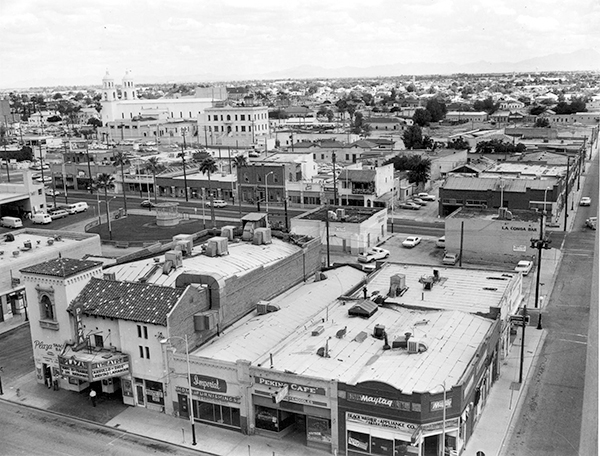 EVENT:
EVENT:
Barrio Stories Project
Thursday & Friday – March 3 & 4 @10am
Saturday & Sunday – March 5 & 6 @ 11am
by award winning playwrights Elaine Romero, Virginia Grise, and Martin Zimmerman.
Directed by Marc David Pinate.
Produced by Borderlands Theatre
Staged outdoors on the grounds of the Tucson Convention Center, this theatrical spectacle brings to life oral histories of Tucson’s original Mexican American neighborhood demolished with the building of the convention center in the 1960s. Precious memories come to life as audience members take a theatrical tour of what used to be the bustling epicenter of commerce and public celebrations for Tucson’s Mexican-American community (some seating is available.) Four vignettes and performance installations encountered throughout the plaza culminate in an interactive post show pachanga – featuring folklorico and mariachi youth ensembles with interactive art and audio booth for all ages. Barrio Stories takes place March 3-6, 2016, as part of Borderlands’ 30th anniversary season. Complete information at BarrioStories.org
Ai Weiwei’s Dazzling Political & Cultural Zodiac Hits the TMA
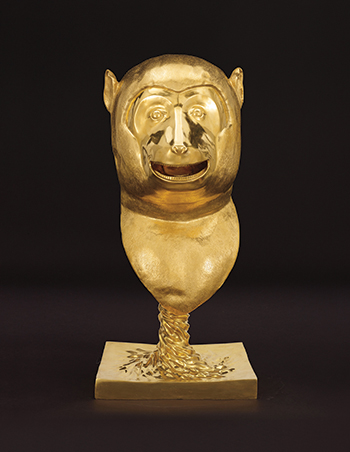
Zodiac Heads, Gold Monkey, by Ai Weiwei
The art world has been in love for some time with Chinese artist Ai Weiwei, thanks to a fabulous 2012 documentary (Ai Weiwei: Never Sorry), his stunning “bird’s nest” Olympic stadium design and countless exhibitions around the globe, such as the recent installation at Alcatraz prison. Weiwei is not just the latest flavor in the art world, he is a genuine genre-busting genius who frankly has few, if any peers in contemporary art. Weiwei is somewhat less appreciated for his brilliant takes on culture, history, appropriation, world politics and the interplay of each of these things with each other. His Circle of Animals/ Zodiac Heads: Gold at the Tucson Museum of Art, is both beautiful and a profound statement about so much more than beauty.
On display in the lower reaches of the main galleries at the museum, the work is a semi-circle composed of 12 oversized animal heads made of gold-gilded bronze set on wooden pedestals. The work, from 2010, depicts the 12 animals of the Chinese zodiac, which includes; a snake, dragon, bear, horse, dog and others. While the sculptures are exquisite to look at, with lifelike details including human characteristics in some of the heads, it is really the back-story that makes this a powerful piece of artwork.
The series, his first major public sculpture project, has been on tour in two formats; bronze, and in gold, since 2011. While the work will also appear in Phoenix later this year, Tucsonans get to see it first as it will be on display through June 26. Previous stops of the tour read like a who’s who of destinations including; the Tuileries Garden at the Louvre, the Hirshorn in DC, the LA County Museum, Cleveland Museum, The Adler Planetarium in Chicago and also stops in London and Brazil.
The original heads in the piece were part of the famed water clock fountain at the imperial retreat in Beijing, China and were designed by the Italian Jesuit Giuseppe Castiglione. The palace, elaborate gardens and fountain were destroyed in 1860 by British troops during the second Opium war, and looted as an act of revenge by Lord Elgin who also looted the Acropolis in Athens. Just seven of the twelve heads survived, and when they surface outside of the country at auction, they are a sore point as many Chinese believe they belong in China and not in the west. Weiwei thinks otherwise, and his interpretation of the work, as an oversized commentary, includes his own versions of the five lost heads, and his work speaks to questions of power, cultural appropriation, art and world history.
Ironically, Weiwei’s outspoken criticism of his home country, which gets him in trouble on a regular basis, is a direct result of the Chinese government’s treatment of his family that started when he was just a small child. His father, a renowned poet, was exiled for decades and as soon as Weiwei was able to travel to the west, he did. He landed in New York City at the perfect moment of time to hone his artistic and activist skills, arriving on the international art scene in 1999. He then found even more international acclaim due to his work on the Olympic stadium in 2008 with the Swiss architects Herzog and De Meruon. But things went south in 2008 when Weiwei created an artwork criticizing the government after the devastating earthquake that caused the collapse of 7,000 schools. This led to his being beaten by the police and his eventual incarnation for trumped up tax evasion charges. Weiwei was eventually freed and allowed to leave China and currently resides in Berlin, Germany where he teaches and continues to create work that is both beautiful and thought provoking.
Two of the missing original five heads in the series, the dragon and ram, were recreated and re-visioned by Weiwei based upon period research of similar artwork during the Ming (1368-1644) and Qing dynasty (1644-1911). The other three “new” heads of the rooster, dog and snake, were made after real life observation of the animals and have a slightly modern feel to them, which brings the work into a contemporary frame of mind. In addition the scale, and elaborate presentation in gold turns the original, smaller water fountain nature of the historic work on its end. Weiwei has taken something that was originally opulent and quite frankly multi-ethnic, with its European design and Asian history, and made it grossly obese and garish for the modern global world.
This is an important and thoughtful work of art by one of the world’s most important living artists that really needs to be seen in person. Do yourself a favor and spend some time with the installation, as it is presented in a way that you can walk around each head and really examine them, but also keep in mind the tortured history that they represent and the role artists take in communicating messages across time.
Ai Weiwei: Circle of Animals/Zodiac Heads: Gold is on display at the Tucson Museum of Art, located at 140 North Main Ave. through June 26. TucsonMuseumofArt.org
Artifact Dance Goes Back in Time for The Grand Parlor
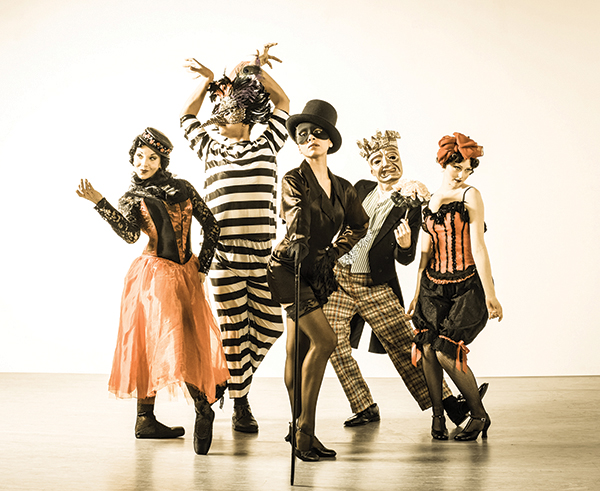
Artifact dancers Claire Hancock, Julian Johnson, Cindy Cantos, Bill Patterson, Alissa Dill. photo by Ed Flores
Tucson’s dance world has been blessed with a number of remarkable groups over the past 30 years. We’ve seen companies who have delivered traditional, timeless works like clockwork, as well as groups who have pushed the performance envelope with their content and audience experience. In the art world today, both locally and nationally, collaboration is the key to engaging and entrancing an audience, and the Tucson-based Artifact Dance Project is clearly both an innovator and practitioner par none. The group’s March performance at the Tucson Scottish Rite Cathedral is entitled “The Grand Parlor,” and it has all of Artifact’s signature elements on display in a smorgasbord for the senses.
According to Artifact’s Managing Director and Co-Artistic Director Ashley Bowman, the performance is envisioned as an “Americana Vaudeville” evening of years past. The wide variety of acts, includes modern dance, tap, a contortionist, a little clown work and even homage to Noah’s ark. As with all Artifact Dance performances, music is a key element to the experience. Ben Nisbet has again created the sonic portion of the evening, which will be performed live during the evening. Works include classical standards such as; Saint Saen’s Danse Macabre and Rossini’s Barber of Seville overture along with works by Dvorak, Tchaikovsky, Schubert and Gershwin. Musicians for the evening include; Derek Granger, Ken Marrs, Mary Turcotte and Samantha Bounkeua. A ringmaster, Artifact Dance company member dancer Cindy Cantos, will guide the intimate audience on their journey through the evening’s 14 vignettes, which will also feature a short intermission. The show is both family friendly and adult friendly with cocktails available to complete the cabaret experience for those of appropriate age.
Of special note is the location for the “Parlor” performances, in the Tucson Scottish Rite Cathedral’s Grand Parlor. The building, listed on the National Register of Places, recently celebrated its 100th anniversary and is a local landmark that would have hosted events such as this in the past. The local Masonic Order still uses the facility for functions, but recently it has been used more and more by the community for special events, largely due to its vintage character and downtown location. Several of last year’s Tucson Fashion Week runway shows made use of the space very effectively, and the Artifact’s Grand Parlor performances will again transform the space into a unique location for arts performances. With such a wide variety of components to the show, it’s hard for Bowman to pick a favorite section. One has to imagine that the entire presentation of a modern dance company’s interpretation of the American Vaudeville performance style in a century-old building, will be something to remember for a long time. This is sure to be one of the performing arts seasons highlights.
The Grand Parlor, by Artifact Dance Project takes place March 18-19-20 at the Tucson Scottish Rite Cathedral, located at 160 S. Scott Ave. Tickets are $25 or $20 for students and are available in advance or at the door.
Get Around on the Free GemRide Shuttle
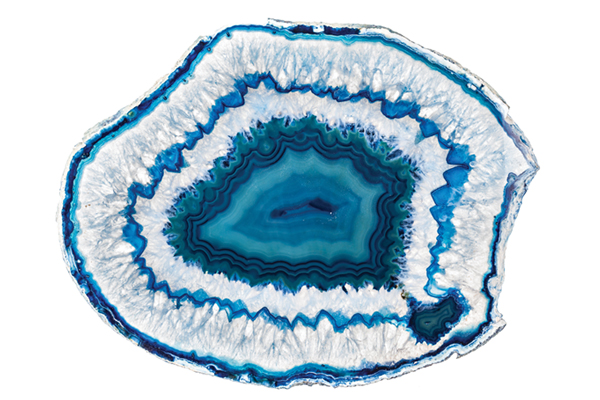 Park your car and get on the free GemRide shuttles to get around the Tucson Gem, Mineral & Fossil Showcase. The free GemRide shuttles will run daily through Sunday, February 14, on three routes:
Park your car and get on the free GemRide shuttles to get around the Tucson Gem, Mineral & Fossil Showcase. The free GemRide shuttles will run daily through Sunday, February 14, on three routes:
Downtown Gem Loop
8 a.m. to 7 p.m.,18 shows from 6th Street to 25th Street, including at the Tucson Convention Center.
Mineral & Fossil Loop
8 a.m. to 7 p.m., 15 shows between Downtown and Grant Road.
Kino Gem Loop
9:30 a.m. to 6:30 p.m., 9 shows at, south and east of Kino Sports Complex.
Free GemRide shuttles on a fourth route will run daily through Monday, February 8:
Bead Loop 9:30 a.m. to 6:30 p.m., 4 bead shows on Ajo Way, Alvernon Way, South 4th Avenue and Pennsylvania Street.
Park for $5 all day ($10 for RVs) at the Downtown West Hub, 700 W. Congress, where you can get on both the Downtown Gem Loop and the Mineral & Fossil Loop. Parking is free at the Tucson Expo Center, 3750 E. Irvington Road, where you can get on both the Kino Gem Loop and the Bead Loop.
Details at GemRide.com
The Gem Show Scene
 When talking about Tucson’s annual Gem, Mineral & Fossil Showcase, people who have been around a while will tell you that it’s changed, that it’s not what it used to be and that nothing is as cool as it was in the good old days. “For years I used to shop for people who live in town, “says Aspen Green, a long time Tucsonan; “people who did not want to be seen because they were too well known. They’d give me a list and $1,000 and I would know exactly where to go to find just the right piece of amethyst or rug or clothing or beads. I had passes to all the shows and I knew just where to get all the good stuff!
When talking about Tucson’s annual Gem, Mineral & Fossil Showcase, people who have been around a while will tell you that it’s changed, that it’s not what it used to be and that nothing is as cool as it was in the good old days. “For years I used to shop for people who live in town, “says Aspen Green, a long time Tucsonan; “people who did not want to be seen because they were too well known. They’d give me a list and $1,000 and I would know exactly where to go to find just the right piece of amethyst or rug or clothing or beads. I had passes to all the shows and I knew just where to get all the good stuff!
“But it’s changed,” she laments, “about five years ago when different shows started moving around town and the state started charging sales tax.” Now with a full time job at UA Presents, whose busiest season conflicts with The Show, annually held the first two weeks in February, Green has neither the time nor enthusiasm to go out and enjoy the show, much less work it.
But while this may be true for Green and others who have seen more than their fair share of Street Fairs, Tucson Meet Yourself and other annual events that may have lost their one time appeal, this is a two week extravaganza that consistently demands to be seen with fresh eyes. Aside from how vast and expansive it is, this is a time when literally hundreds of millions of dollars’ worth of precious stones, crystals, minerals and metals inundate our city. There are those in fact who will swear there is an actual shift in the vibrational space/time continuum. But its not just rocks and such as but also clothing, jewelry, fossils, glasswork, beads and beadwork of every conceivable nature, here to be bought, sold, traded, haggled over or simply admired. Add lots of music, parties, the marathon glassblowing competition and a cast of characters straight out of Central Casting including wholesale buyers, sellers, gemologists, jewelers, import/export people, musicians, hippies and ex-hippies now masking as straight laced business types. It’s a wonder no one has seen fit to make an indie movie of this scene.
“What makes it special are the people who come back every year.” So says Sirena Jan Allen who has worked a booth at the show for various out of town vendors for almost 20 years. Initially working for a seller of Peruvian clay and hand painted beads, she loved the opportunity to meet people from all over the world. “There is an excitement that builds,” she says that comes from being a part of so many different reunions taking place with folks who only get to see each other for these few days every year.
Actually, the Gem, Mineral & Fossil Showcase is a bit of a misnomer. A cursory search on Google will reveal a schedule that features no fewer than 40 different shows or expos spread throughout the city (tucsongemshows.net) . Some are strictly wholesale and some require official badges. But most are open to the public, with many housed in huge tented areas or spread across hotel rooms, suites and balconies.
Some of the better known hot beds of activity include what used to be known as the Holidome on Palo Verde and Irvington; the tents set up by TEP Park on Ajo and Country Club and of course the fortnight’s grand finale in the Tucson Convention Center, a high end show according to some, where there is also an admission charge.
Congress St., just west of downtown is also an area that usually houses a huge tented area. But it is the I-10 Frontage Road, running from Grant Rd. to just south of 22nd St., with all of its roadside motels, that provides a huge cornucopia of (for lack of a better word) stuff, for anyone interested in cruising the side of the highway on bicycle or foot with thousands of other bargain hunters, curiosity seekers and people watchers.
And speaking of the strip, at the very south end of the Frontage Road, just south of 22nd St. is the African Village. This is one of the true gems (pun intended) of the entire show. In what is normally a huge vacant dirt lot, this space is annually transformed into a place of drums and other instruments, masks, lanterns, necklaces, jewelry, clothing, furniture, etched glass and so much more with one vendor after the next representing a unique part of the African continent. This is truly a land of many cultures. For many who frequent the show, a trip to the African Village serves as an annual pilgrimage in and of itself.
And finally, at the other end of the strip by Grant Road, is the Gem and Jam Show (ticketfly.com) What began as a single night of music at a Fourth Ave. Club, has morphed from those humble beginnings into its current incarnation as a full fledged three day Festival complete with three day passes, hotel packages and other festival perks.
Alan, a wholesale buyer from North Carolina and one of those guys who could be from Central Casting, is a fitness buff and may spend half his time here bicycling into the Catalinas or even New Mexico’s Gila Wilderness. But he still remembers the time when he got to see a 50 karat chrome tourmaline and an emerald green garnet worth $300,000. “And everybody is a wheeler dealer,” he says with a wry smile. With so much to take in, what’s still not to like?

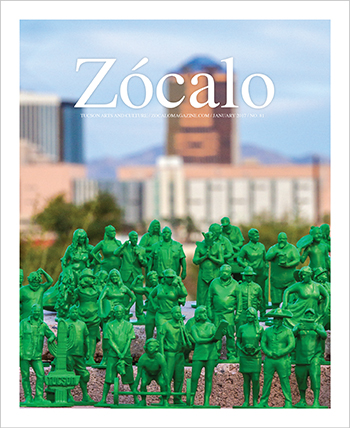
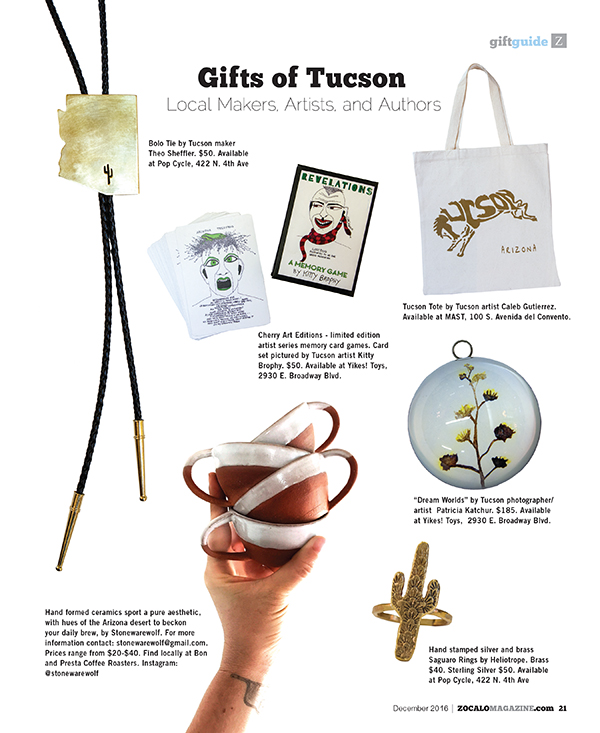
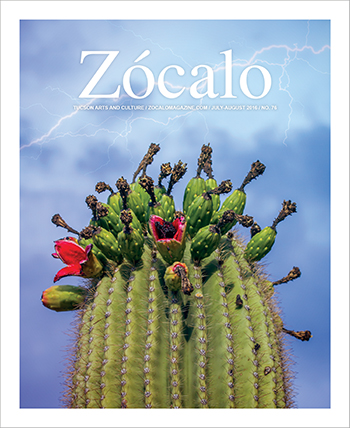
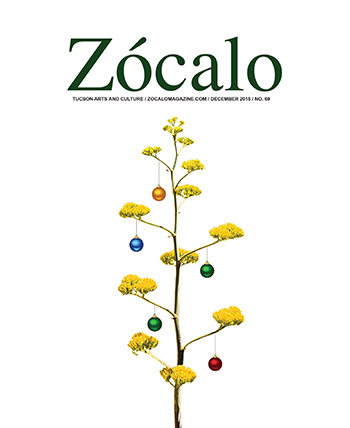




Also find us on...